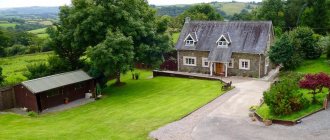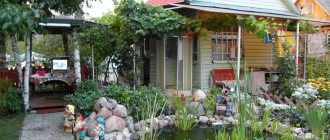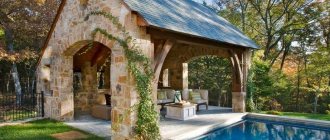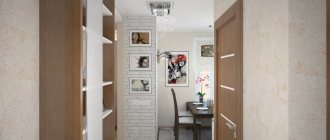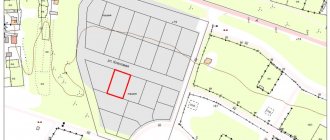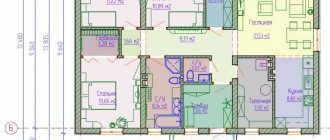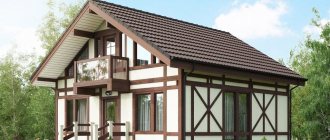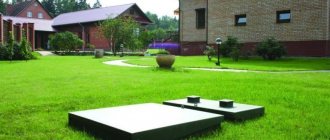When there is no choice, for example, the plot was inherited, you have to be content with what you have.
Often owners give up and abandon such territories, but in vain. Even if you got a narrow area, this is not a reason to be upset.
Such an area can be properly developed if you approach the work responsibly, study the norms and requirements for construction, develop a house plan and choose the layout of your household plot.
What kind of memory is considered this?
According to standards, a narrow area is considered to be one whose width varies from 8 to 20 meters. Take, for example, an area of 6 acres: its normal, customary size is 20x30 meters, but 10x60, 12x40 meters are the same 6 acres, but narrow and elongated. Other variations in the ratio of the length and width of the territory are possible.
The allotment can be located longitudinally or transversely. If everything is more or less clear with the usual dimensions, then not everyone knows how to build on a narrow territory.
Parameter requirements
The parameters of land plots are regulated at both the federal and municipal levels. Federal acts are :
- Land Code of the Russian Federation.
- SNiPs.
- Town Planning Code of the Russian Federation.
- Federal Law No. 123 “Technical Regulations on Fire Safety Requirements.”
The Land Code indicates that the maximum plot size is established in accordance with urban planning regulations.
Each region has its own standards for the size of land plots, the average is 50 acres. As for the minimum sizes, they should be :
- for construction: width – from 8 meters, total size – 300 sq. m.
- for farming: width – from 12 meters, total size – 500 sq.m.
When planning to build a residential building on such a site, you must remember that regardless of the width and length of the territory, you must follow the established standards. This is regulated :
- SP 42.13330.2016;
- SP 53.13330.2011;
- SP 30-102-99.
The regulatory document regulating the location of buildings on the territory is SNiP 30-02-97. Clause 5.3.2 states that the minimum distance from a residential building to the street line is 5 meters; utility buildings must be located at a similar distance from the red line of the streets.
Country house
Most owners of suburban areas conditionally divide their territory into several functional zones.
These include:
- Residential area, including a country house and outbuildings (bathhouse, terrace, balcony, etc.).
- Recreation area - flower beds, playgrounds, gazebos, etc.
- Gardening area.
In all these territories we can create a truly unique atmosphere, and with minimal financial and time costs. We just need to give free rein to our imagination and try to find uses for the most ordinary things.
Let's start describing the ideas for creative transformation of our dacha with the house itself:
The structure itself is usually built from traditional materials. The basis can be a container, a frame made of wooden beams with panel cladding, or a brick load-bearing “box”. At the same time, there are also original models of country houses that use, for example, empty glass bottles as building material.
To decorate the walls of even the simplest house, you can plant them along them. Climbing along pre-stretched cords, they will quickly braid the entire building right up to the roof, and we will only have to periodically thin out the greenery in front of the windows and doors.
Inside the house there is also a place to use your creative skills. The wisest decision would be to refuse to use furniture, which we send to the country “exile” after losing its presentation. Creative tables and chairs made from irregularly shaped branches and roughly sawn logs will look much more attractive.
Advantages of elongated chargers
Despite the apparent problem, narrow, elongated sections have a number of undeniable advantages :
Affordable price. The price for “wrong” plots is usually several times cheaper than the cost of ordinary land of a similar area.- Possibility to zone space. With the help of a specialist, you can visually divide the territory into zones.
- With proper planning, it will be possible to use all the available space.
- Opportunity to start a mini garden. Even a small area can be designed so that the garden will not be conspicuous.
Especially in narrow areas, lovers of various vines and vineyards can “accelerate”. These plants are simply irreplaceable in decorating such areas.
Initial Design Principles
The ideal option is when the area is absolutely clean. In this case, all barriers to creativity are simply absent. You need to start creating your ideal vacation spot with design. Layout of a narrow site is not an easy task. It is immediately necessary to determine the list of structures and objects that should be located on the territory. Standard list of objects that are important for most summer residents:
- car parking (garage);
- bath;
- alcove;
- playground;
- greenhouse or other options for outbuildings.
The small territory of a narrow summer cottage very often does not allow to accommodate all the desired objects. In this case, you should decide what is preferable: rest or work on the land; aesthetics and comfort or practicality. After setting priorities, you can begin to create a site design.
Minuses
If we talk about disadvantages, such plots, of course, have them, among them:
- Inability to build your dream home. The narrow dimensions of the plot do not always allow you to build exactly the house you wanted.
- Lack of tall trees. In narrow areas, regardless of their length, you will have to abandon large trees, since their crown will shade the area and visually make it even smaller.
- Inability to isolate yourself from neighbors and the road. It is not recommended to install a blind fence around the perimeter of a narrow area.
- Additional expenses for arrangement. Narrow areas are considered difficult to work with. Without skills or special education, it is unlikely that you will be able to improve the territory. Therefore, you will have to hire professional landscape designers.
How to adjust space
This is the next question that comes up sharply after drawing up a zoning plan for a narrow area. There are a lot of visual correction techniques. Which of them is rational to use in our case?
First of all, try to use every inch of the space, including seemingly non-functional corners and the deepest corners. The main thing is not to repeat the chronic mistakes of narrow section design. For example, do not plant tall trees around the perimeter. Their height will only aggravate the situation and present the territory as even more elongated and disproportionate than it actually is.
Do not plant tall trees around the perimeter of the plot
The right effect will be achieved by planting this type of vegetation at the very end of the territory, along the short side. In the design of a long plot, bring low-growing subspecies of shrubs and fruit-bearing trees to the foreground. This is a great way to open up a space and give it a domesticated, lived-in feel.
Low-growing shrubs will make the area wider
You may not strive to maintain the visual integrity of the plot. A torn picture will also distract from the shortcomings of the land layout. In the design of an elongated site, follow a policy of clear zonal division of areas with an emphasis on highlighting the boundaries of functional parts. To do this, feel free to involve all kinds of architectural forms in the project, from symbolic fences to luxurious pergolas and arches. These elements will help shade the real boundaries of the object.
Emphasizing the boundaries of functional parts
Experts recommend trying to zoning a narrow area in another way. Divide it into several parts so that you can later fill them with sand, pebbles or sow them with grass. This approach is justified if the zones are not planned to be separated by solid fences and the entire territory remains visible.
In the design of a narrow area, you cannot use geometrically clear lines. This means that alleys and paths need to be made cleverly winding, meandering randomly among the trees. If you plan to lay the paths with tiles, then lay it in some kind of pattern, perhaps even ornamental.
Smooth lines will visually expand the boundaries of the site
Similar tactics must be followed when decorating flower beds in a narrow area. Flower beds are also given irregular shapes. In this case, the courtyard area seems wider, the garden – more voluminous.
An excellent counterbalance to the elongated shape of the allotment will be green spaces with spherical crowns.
A painful issue in the design of a long plot is the fence. If giving it up completely is unrealistic, then make it low, ideally multi-level and multi-colored. Low-growing weaving plantings can serve as additional decoration.
Decorate the fence with climbing plants
In the struggle to expand the site, it is permissible to use transverse lines. They can be depicted in borders, flower beds, or a strip of green hedge.
The transverse design will bring balance to the perception of the elongated territory.
Cross zoning brings balance
Bringing distant areas closer
If you did not get a virgin plot of land, but it was already inhabited by someone else, then perhaps for the successful design of a narrow plot you will also need to use techniques for visually zooming in/out of objects. For example, at the end of the garden there is a tall, beautiful tree, which is extremely frustrating to cut down. Use it for practical purposes. Plant another one diagonally from it, but only a smaller tree. This step will visually shorten the space. A good way to bring the remote part of the area closer is to include in the design of the elongated area a small gazebo, which, surrounded by flowers, will spread out in the backyard. If you don’t want to build a gazebo, put a fountain there or build a multi-tiered flower bed.
Popular articles Decorative fencing for garden beds: which ones to choose and how to use
The gazebo will bring the remote part of the site closer
When designing a narrow area, you will need to focus on at least three objects. These could be: garden sculptures, decorative arches, secret gates
The background of the territory is designed brightly and colorfully, while near the entrance everything should look restrained. A cold palette is more appropriate here.
Bright flowers will visually expand the area
In the corrective design of the shape of a narrow area, green spaces are actively used. So, to visually expand the area, tree-like plants with large, bright yellow leaves or plants that bloom in yellow-orange are planted in the garden part.
What zones should be on the territory?
When planning the zoning of non-standard household plots, you need to know the basic rule - the division of the territory should be carried out crosswise . As for the number of zones, their number can reach 6 separate spaces, depending on the length of the territory.
Representative
Another name for it is the front zone. It is located near the front entrance to a residential building. In this zone you can place :
- alpine slides;
- break up flower beds.
When using a lawn, it is recommended to choose asymmetrical varieties. In the same space, you can allocate space for a car, but it should be located to the side, and in no case in the middle of the zone.
Buffer
It is located immediately at the entrance to the territory. Arranging this area is not necessary , but if the size of the plot allows and the owner has a car, it is better to organize it.
You can separate the buffer space from the front space with the help of tall, dense bushes and plant thujas. Another option is to lay out a decorative brick wall, but you need to understand that it can obscure the space.
Private
This is the so-called recreation area, a place where you can retire from noise . To separate it, you can use trellises, pergolas, or you can build a curtain. The space of the private zone can be ennobled with vines and climbing plants. In the center of the zone you can put a gazebo, arrange a green office, or simply hang a hammock.
Specialized
This area is intended for domestic needs. There you can place change houses and a place for drying clothes. If you wish, you can arrange everything beautifully, or you can simply stretch clotheslines, hiding them from prying eyes with curtains and tall bushes.
Unobstructed access must be organized to the specialized area.
Additional
An additional zone can be arranged on long sections.
It may include:
- playground;
- playground;
- garden.
When setting up a playground, it is not recommended to close it off from the front door and the recreation area, since adults must supervise children playing in the additional area.
Some lovers of country life set up a small vegetable garden on their plots in the additional zone. This area should be located near a specialized area.
Small architectural forms, decor
The decor is selected based on the style of the landscape. It is made of wood, ceramics, stone, concrete, plastic, rattan, wire, etc.
What does this include:
- benches;
- garden lights;
- decorative wells;
- miniature fountains;
- sculptural compositions;
- swing;
- doghouse;
- birdhouse;
- flower pots;
- arches;
- bridges;
- forged trellises;
- flowerpot;
- urns.
Many amateurs create decor on their own, from scrap materials - old tires, plastic bottles, driftwood, stones, fragments of old furniture and household appliances. The children's playground, in addition to ladders and swings, is decorated with colored garden gnomes, ducklings, frogs, mushrooms, the paths are sprinkled with colored stone chips and gravel. The place intended for relaxation is decorated with an artificial pond with a waterfall, a bridge, and a grill or barbecue with suitable furniture is placed on the terrace. Weather vanes, signs, and mailboxes will complement the space at the front entrance in an original way.
Rules and regulations for the location of buildings
Before building a house, it is necessary to familiarize yourself in advance with the rules and SNiPs regulating the rules for the location of buildings on a certain site.
House
When building a residential building, you need to know that :
- the minimum distance from the building to the neighbor’s fence is 3 meters;
- the distance from the house to the red line of the street is 5 meters;
- the minimum distance from the house to the road is 3 meters;
- The roof on the roof of the house must be arranged in such a way that water and snow do not fall into the neighbor’s territory when they fall.
Garage
A garage is considered an outbuilding, so it is subject to requirements similar to all outbuildings , namely:
- The minimum distance from the boundary is 1 meter;
- The distance from your neighbor's house to your garage is 6 meters.
The garage should be located in such a place that snow and water from its roof do not fall onto the adjacent area.
Detailed information about the construction of garages is here.
Bath
Like any outbuilding, the bathhouse must meet certain requirements :
- minimum distance from the road line – 5 meters;
- distance from the neighbor’s house – 6 meters;
- boundary distance – 1 meter.
The bathhouse should be located in such a way that snow slopes from the roof do not fall onto the neighboring territory.
All the details of building a bathhouse are available here.
Outbuildings
According to the recommendations, it is better to erect outbuildings in the depths of the site, the minimum distance from the roadway is 5 meters .
There are no special restrictions on the location of buildings on its territory. If you plan to build a premises for keeping animals, then there are certain nuances. In particular, the minimum height of such a structure is 2.5 meters, and the distance to a residential building is 5 meters.
Everything you need to know about the construction of outbuildings is here.
Advantages and disadvantages of a narrow section
A piece of land less than 15 meters wide is not a very successful, but very common layout, which has its pros and cons.
Positive sides:
- lower cost than a square plot of land;
- convenient zoning of space. Example: on one side there is a garden and vegetable garden, in the middle there is a house, behind it there is a garage and outbuildings;
- the design of a house with a smaller width includes large attic windows;
- a single-flight ladder along the wall will originally complement the facade, decorating it;
- If you decide to set up a vegetable garden, it’s easy to make it inconspicuous.
Negative points:
- it is problematic to accommodate a wide, square house, and a very narrow one will have to be well insulated, since it freezes more strongly;
- neighboring houses are located too close, they can shade part of the site, a lower building;
- difficulties with placing a garage - close to the house it will disrupt the composition of the yard, and if located far away, the road to it will take up a lot of usable space;
- a narrow garden in which it is impossible to plant trees that are too tall - they will shade the garden;
- when the site is located near the road, problems with high-quality sound insulation are possible.
To keep the house from being completely cramped, small-width furniture is used, as well as built-in furniture.
Tips for visual correction products
If practically expanding the boundaries of a narrow personal plot is quite problematic, then visually this can be done if you put in some effort. There are several tricks that can visually expand the territory:
- Planting trees of different sizes. Moreover, they need to be planted in a certain way: tall varieties are planted at the end of the plot, and dwarf varieties are planted at the beginning.
- At the end of the garden, plant large-scale plants, vines, and flowers climbing along the arches.
- Focus on a bright object located deep in the territory. For example, put up a gazebo and plant bright flower beds around it.
- Lay garden paths along low-growing plants.
- Plant medium-sized flowering plants in cool shades along the fence.
- Tall trees, including fruit trees, cannot be planted around the perimeter.
In addition, to visually expand the allotment, you can use a variety of decorative elements and create a multi-level landscape.
Multi-level design
If the site is uneven and sloped, then organizing such a design will be cheaper.
If the area is flat, you will have to create levels artificially. It is best to raise the central part of the site. But if the buildings do not allow it, then you can raise the far part of the plot. By raising the central part, it will be possible to visually hide the distant part of the territory.
It is recommended to design the resulting territories in the form of terraces. If everything is done correctly, the integrity of the site will be compromised and the area will not seem long. Additionally, the descent from the elevated area can be equipped with a path with steps.
On the elevated area you can set up a recreation area, or you can build an alpine slide.
Another option for arranging a multi-level design is to plant plants of contrasting lengths. Additionally, you can make an embankment of soil. The vertical method of gardening visually expands the space. To create green walls, you can use arches, trellises, and pergolas.
Decorative elements
Decorative elements can significantly transform any garden plot. However, certain decoration methods are suitable for different areas. For extended areas it is recommended to use :
- Hedges. Excellent for demarcating zones, visually expanding the territory.
- Flower borders. With their help you can improve the paths. Flower borders should have smooth outlines, plants of different sizes should fit harmoniously into the overall picture. For such flower beds it is best to use chrysanthemums, irises, and varieties of cereals:
- Pergola. The arrangement of this element will not only add an element of decor, but also divide the territory into zones. The good thing about a pergola is that it can be made in any shape and from any material.
- Relief flower beds. With their help, a narrow area can be visually expanded. Such flower beds are good because they are easy to set up and easy to care for. You can plant low shrubs and perennial flowers in such flower beds.
- Mixborders. They are rectangular flower beds. They can be installed both at the border of the plot and along the paths. The peculiarity of mixborders is that plants of different colors, sizes and flowering times are collected in one flowerbed. That is, such a flowerbed will delight the owner with its flowering from spring to late autumn.
Not only plants can serve as decoration.
In the design you can use:
- decorative lamps;
- flowerpots;
- furniture;
- sculptures;
- artificial reservoirs and so on.
You need to choose the right sizes and colors of decorative items.
Stylistic directions for a narrow area
The style of the landscape depends on the area of land ownership, the personal preferences of its owners, the most popular:
- minimalism - there are very few details, which is convenient for small plots. The buildings are only necessary; instead of lush flower beds and trees, there are neatly trimmed lawns and bushes. Volumetric embankments, smooth paths, straight trellises for climbing plants are allowed;
- hi-tech - a lot of metal, glass, mirror elements. Gray steel fence and chrome furniture in the sitting area, mirror. Repeating the outline of a small pond, framing the flower beds with borders painted with silver paint;
- eastern - low bushes and trees, alpine slides with many stones and pagoda gazebos. Smooth lines, rounded ponds, ornamental plants from China and Japan, and low wicker furniture are welcome. Symmetry and right angles are completely absent;
- English - perennial plants of different heights predominate here, winding paths paved with coarse gravel or tiles. Reservoirs, practically indistinguishable from those found in the wild, are organically combined with flower beds and carpets;
- country - the beds are located almost chaotically, pumpkins and peppers grow in the flowerbeds, and flowers - wherever necessary. Stylized crane wells, wooden wheels and carts, and fragments of fences woven from wicker are used as decoration;
- Baroque - suitable only for spacious areas. Lush rose bushes and openwork gazebos with columns, antique sculptures and decorative fountains. Forged garden furniture and gilded elements create the most luxurious design;
- forest - only natural materials are used, forest trees, mossy stones. Wooden buildings and beds are made inconspicuous. The land tenure resembles a plot of real forest, with small accents - the redevelopment here is very minimal.
Tips for choosing a style
The problem with a narrow long area is that its arrangement needs to be approached competently, otherwise the area can simply be reloaded. Therefore, it is recommended to seek the help of specialists.
When choosing a design for such an area, it is recommended to choose discreet styles that do not contain clutter of decorative elements.
Minimalism
The style is simple and concise. The peculiarity of minimalism is geometrically correct forms. You can use installations made of wire and mirrors in your design. The main color is green. It is complemented by light shades: white, beige, light pink, gray. You can make a bright color accent, but the main thing is not to overdo it.
Using this style, it is difficult to visually expand the space. Despite this, minimalism is often used when improving suburban areas.
Japanese style
The essence of this style is asymmetry. For visually expanding a narrow area, the Japanese style is most suitable. A Japanese-style garden always includes stones, plants, and water. The water problem can be solved by constructing a simulated stream. All you need is gravel and pebbles.
As for plants, there should be a lot of them and they should be everywhere. The asymmetry of the Japanese style means that both low varieties of plants and high varieties of flowers and shrubs can be planted nearby.
Eco style
Its peculiarity is naturalness. An eco-style garden should seem like a space untouched by humans. Depending on climatic conditions, almost any idea can be brought to life in eco style.
It is almost impossible to arrange an area in eco-style on your own, since you need to know exactly which plants can grow together in the wild and which cannot. When arranging gazebos, benches, and paths, you must remember that they all must be made of natural materials.
Alpine style
This option is perfect for areas with uneven terrain. The emphasis in the alpine style is on the stones. Paths are laid out of this material and gazebos are built. It is better to combine shrubs and low coniferous trees with stones. There should be few flowers.
The advantage of the alpine style is that maintenance of an area made in this style is minimal.
Country
The rustic design style is very popular among lovers of country life. The characteristic features of country style are simplicity, lightness, and some randomness. Rustic style involves the use of wooden furniture, wicker baskets and similar decorative items. Clay pots and various figurines will fit perfectly into the country style.
For garden lovers, the rustic style is an outlet. The style assumes the presence of fruit trees and vegetable beds. Even flower beds can be laid out not with flowers, but with vegetables. They will fit well into the design of beds with spicy and medicinal plants.
As for flowers, there is no need to give them up. It’s just that you don’t need to allocate separate flower beds for them; you can plant flowering plants in free space.
If the site is very long, then you can take a walk and consider other styles, for example, high-tech, Mediterranean, exotic.
Briefly about the main thing
In order for the garden on the site to be picturesque and functional, when arranging the territory it is necessary to rely on a well-thought-out project and a well-developed plan of the area. All significant objects, plants, communications, as well as future buildings and plantings are plotted on the plan.
Landscape tricks will help give the site a harmonious, complete look. Many of them relate to the organization of space, the choice of the center of the composition and color palette, and the way to organize a lawn or flower bed. Fashionable landscaping techniques will help you design your site in such a way as to minimize maintenance.
Photo
What options there may be for planning an elongated section can be seen in the photo:
Mirror effect
You can even place a decorative pond in a small area. It is clear that the reservoir will be small, but even this will contribute to the desired optical focus. The calm surface of the water, like a mirror, reflects on its surface the sky, clouds and everything that is around the pond. This effect makes the garden seem larger than it actually is. The elongated rectangular shape of the reservoir also plays into its favor: this configuration visually lengthens the area.
The calm surface of the water, like a mirror, reflects on its surface the sky, clouds and everything that is around the pond. This effect makes the garden seem larger than it actually is. The elongated rectangular shape of the reservoir also plays into its favor: this configuration visually lengthens the area
In a small garden, geometric shapes look great: square, rectangle and circle. Elements of such configurations bring order and clarity to the structure of the entire garden plot - be it a flower garden, terrace or pond. Narrow, level paths and straight hedges will help to optically enlarge the garden.

